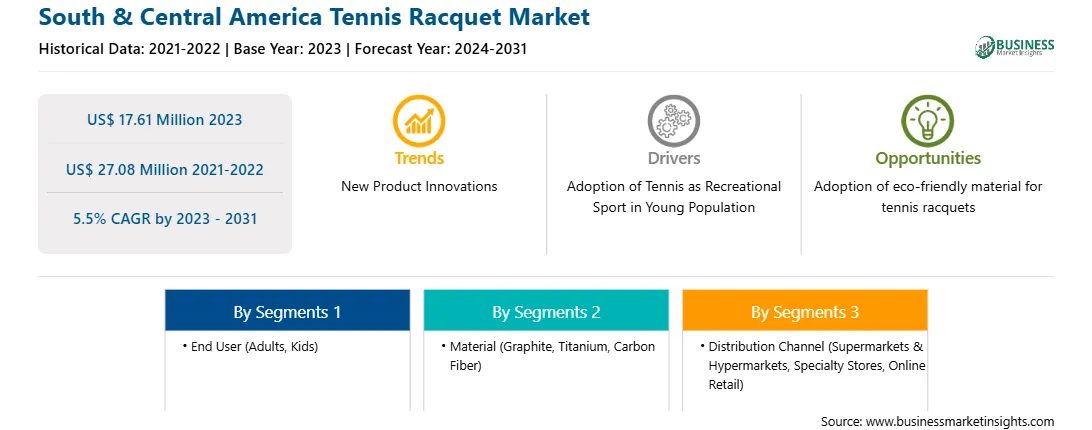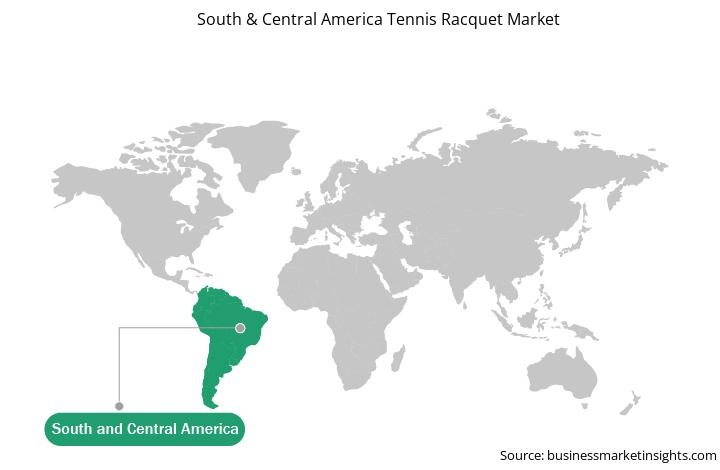The South & Central America tennis racquet market was valued at US$ 17.61 million in 2023 and is expected to reach US$ 27.08 million by 2031; it is estimated to register a CAGR of 5.5% from 2023 to 2031.
From most tennis consumers ' viewpoint, the life cycle of a tennis racket is just from purchasing a brand-new racket to tossing away a worn-out racquet. However, the life cycle of a racquet is beyond that when environmental impacts are considered - from obtaining raw materials to decomposing the racquet. Assessing the life cycle of the tennis racquet opens another standpoint for consumers, especially looking into the materials needed to make, transport, distribute, and recycle a tennis racquet, which indicates the impact of a single tennis racquet on the environment. In February 2022, the Public Environmental Center for Sustainable Development (PECSD) found that over 90% of the one-and-a-half tons of waste collected are plastic bottles, cups, bags, stirrers, utensils, sunscreen wrappers, belts, toys, and even tennis racquets. Hence, manufacturers are adopting advanced technologies in manufacturing tennis racquets to minimize tennis racquet waste and encourage players to adopt eco-friendly tennis racquets. For instance, on April 22, 2022, Wilson Sporting Goods announced the launch of their eco-friendly tennis racquet series in celebration of Earth Day. The eco-conscious collection, including three performance rackets, features bio-based and recycled material from Agiplast technology by Arkema and waterborne paints from Sherwin Williams, eventually decreasing the footprint of each racket produced. On the other hand, in May 2023, Luxilon released the first 100%-recycled string used in tennis racquets. Luxilon Eco Power is a performance tennis string innovated from entirely recycled materials composed of old plastic bottles, and the minimalist packaging also trims down on the amount of paper used to lower waste. Therefore, the presence of tennis brands, such as Yonex Co., Ltd., and Wilson Sporting Goods worldwide, operating in the South & Central America tennis racquet market, has elevated sustainability efforts. All these factors are likely to provide lucrative opportunities for South & Central America the tennis racquet market during the forecast period.
The South & Central America region includes Brazil, Argentina, and the Rest of South and Central America. Tennis is becoming more popular in the region as people become more conscious of the importance of a healthy lifestyle. There are increasing tennis events in the region. Several factors are attributed to the positive trends in the tennis industry, including tennis being the ideal social-distancing sport, health benefits, etc. Thus, creating demand for tennis equipment, including tennis racquets, in the region. In May 2022, The Association of Tennis Professionals (ATP) and the Confederation of South American Tennis (COSAT) announced that Rio de Janeiro, Brazil, will host the first-ever ATP Challenger Tour workshop in South America from 14-15 July 2022. The forum encourages open dialogue between tournaments, federations, and ATP staff to enhance the region's existing structure and provide new growth strategies in the South & Central America tennis industry. The region also focuses on providing more opportunities to the players and inspiring younger players to pick up a racquet and give them the incentive to play sports at a large scale. All such factors support the region's tennis racquet market growth.
Strategic insights for the South & Central America Tennis Racquet provides data-driven analysis of the industry landscape, including current trends, key players, and regional nuances. These insights offer actionable recommendations, enabling readers to differentiate themselves from competitors by identifying untapped segments or developing unique value propositions. Leveraging data analytics, these insights help industry players anticipate the market shifts, whether investors, manufacturers, or other stakeholders. A future-oriented perspective is essential, helping stakeholders anticipate market shifts and position themselves for long-term success in this dynamic region. Ultimately, effective strategic insights empower readers to make informed decisions that drive profitability and achieve their business objectives within the market.

| Report Attribute | Details |
|---|---|
| Market size in 2023 | US$ 17.61 Million |
| Market Size by 2031 | US$ 27.08 Million |
| Global CAGR (2023 - 2031) | 5.5% |
| Historical Data | 2021-2022 |
| Forecast period | 2024-2031 |
| Segments Covered |
By End User
|
| Regions and Countries Covered | South and Central America
|
| Market leaders and key company profiles |
The geographic scope of the South & Central America Tennis Racquet refers to the specific areas in which a business operates and competes. Understanding local distinctions, such as diverse consumer preferences (e.g., demand for specific plug types or battery backup durations), varying economic conditions, and regulatory environments, is crucial for tailoring strategies to specific markets. Businesses can expand their reach by identifying underserved areas or adapting their offerings to meet local demands. A clear market focus allows for more effective resource allocation, targeted marketing campaigns, and better positioning against local competitors, ultimately driving growth in those targeted areas.

The South & Central America tennis racquet market is segmented into end user, material, distribution channel, and country.
Based on end user, the South & Central America tennis racquet market is bifurcated into adults and kids. The adults segment held a larger market share in 2023. Furthermore, the adults segment is sub segmented into men and women.
In terms of material, the South & Central America tennis racquet market is categorized into graphite, titanium, carbon fiber, and others. The carbon fiber segment held the largest market share in 2023.
By distribution channel, the South & Central America tennis racquet market is segmented into supermarkets & hypermarkets, specialty stores, online retail, and others. The supermarkets & hypermarkets segment held the largest market share in 2023.
By country, the South & Central America tennis racquet market is segmented into Brazil, Argentina, and the Rest of South & Central America. Brazil dominated the South & Central America tennis racquet market share in 2023.
YONEX Co Ltd, Sumitomo Rubber Industries Ltd, HEAD, GAMMA Sports, PACIFIC Holding GmbH, Maus Freres SA, Babolat, Wilson Sporting Goods, and Authentic Brands Group LLC are some of the leading companies operating in the South & Central America tennis racquet market.
The South & Central America Tennis Racquet Market is valued at US$ 17.61 Million in 2023, it is projected to reach US$ 27.08 Million by 2031.
As per our report South & Central America Tennis Racquet Market, the market size is valued at US$ 17.61 Million in 2023, projecting it to reach US$ 27.08 Million by 2031. This translates to a CAGR of approximately 5.5% during the forecast period.
The South & Central America Tennis Racquet Market report typically cover these key segments-
The historic period, base year, and forecast period can vary slightly depending on the specific market research report. However, for the South & Central America Tennis Racquet Market report:
The South & Central America Tennis Racquet Market is populated by several key players, each contributing to its growth and innovation. Some of the major players include:
The South & Central America Tennis Racquet Market report is valuable for diverse stakeholders, including:
Essentially, anyone involved in or considering involvement in the South & Central America Tennis Racquet Market value chain can benefit from the information contained in a comprehensive market report.